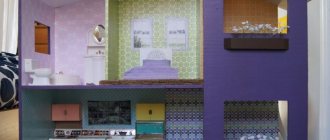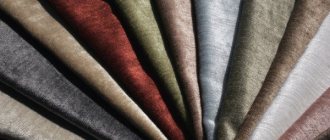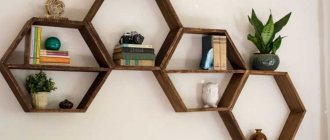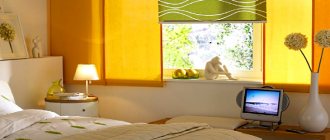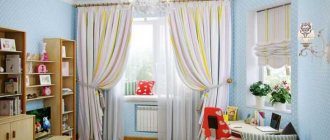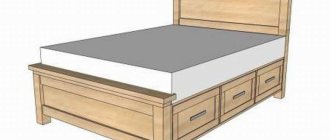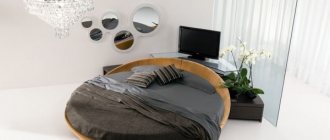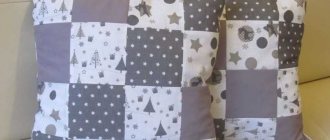Design photo gallery
Advantages and disadvantages
Curtains for a doorway have more advantages than disadvantages. Let's look at the positive aspects first:
- the space is transformed. Decorative curtains can complement the palette or become an eye-catching accent;
- the door is more expensive;
- you can choose designs for non-standard openings;
- You can make a decorative curtain yourself;
- curtains are made not only from textiles. There are wooden, plastic and metal structures. Therefore, you can choose decorative curtains for different styles;
- you can visually adjust the size of the room. For example, you can hang the cornice 7-10 cm wider on each side. This will make the room more voluminous;
- interior renovation. Can be replaced more often than doors made of MDF or wood.
Now a little about the cons:
- the fabric curtain does not create sufficient barriers to noise, aromas and cold air;
- cannot be used in all rooms. For a bathroom or bedroom, doors made of wood or MDF are more suitable;
- Decorative thread curtains can become tangled or become the subject of play for pets.
Several manufacturing examples
If you don’t know how to make curtains on a door, but you have a great desire and material, then just choose one of the instructions below.
Filament curtains
Thread curtains
To make them, you need to purchase the following material:
- lath (length equal to the width of the doorway with a slight overlap at the edges);
- viscose yarn (the amount will depend on the desired density);
- hot glue gun.
After everything is prepared, you can start working, following a simple algorithm of actions.
- Using a tape measure, measure the required height of the product.
- Cut the yarn into equal pieces. The length should correspond to twice the height of the opening plus 10 cm for the formation of loops. For a standard interior opening there are about 500 pieces. elements.
- We process all ends with fire or tie a tight knot so that the yarn does not unravel.
- We fold all the pieces in half and fix them on the rail in the form of a loop.
- The threads should be placed close to each other.
- For reliable fixation, we use glue from a hot-melt gun.
- We create an opening.
When making, you can choose multi-colored threads or complement the curtains with decorative elements, for example, beads. A curtain with threads of different lengths will also look interesting.
Note!
For an arched shape, it is best to choose a flexible plastic corner.
Wooden curtains
Wooden curtains for the doorway
To create such a curtain yourself, you will need decorative elements made of wood of various shapes with a hole inside. Suitable materials are both natural wood and plastic, simulating the structure of wood. In addition, you need to purchase:
- cornice with rings;
- strong thread (fishing line);
- crimps (special clips for fixing decorative elements).
The process of making a wooden curtain is similar to the previous algorithm described:
- The thread is prepared to the appropriate length depending on the height of the doorway.
- The wooden elements are strung on prepared threads and secured on both sides with crimps.
- The finished threads are attached to the cornice rings.
- The decorated cornice is hung above the doorway.
Note!
You can fix the decor with knots or use nothing, then the wooden elements will distribute themselves.
Paper clips
The easiest way to decorate an opening is with hanging curtains made from paper clips. To do this you will need paper clips of different colors. They can be assembled into identical stripes or form an arched passage. The function of a cornice can be performed by a wooden beam. You can screw self-tapping screws into it and secure ribbons of paper clips.
Discs
A decorative curtain made from CDs can be hung in a large interior opening. Such curtains will complement the high-tech style. To assemble tapes from disks, you need to drill 2 holes at the top and bottom. The discs are connected with transparent fishing line or thin wire.
Wine corks
If you have been collecting wine corks, now they can become a bright accent in the room. To assemble the curtains, pierce the corks lengthwise and pass the fishing line through them. You can dilute the monochrome of the decorative design by using beads in rich tones.
How to hang curtains on doors and open passages
Decorative curtains can be attached to the cornice. Select the hanger so that it matches the curtains. The curtain mount must be in the same style as the room where the structure is installed.
- eyelets. The fastening rings can be wooden, metal or made of plastic. Different materials combined with different decors and colors can complement any style. To ensure uniform drapery, curtain tape is used;
- sewing loops. Such interior curtains look airy and weightless. The main condition is that they complement the space - the ceilings must be high;
- hooks. Plastic hooks are used in ceiling hangers. Such fasteners are invisible, and the suspension itself hides the baguette;
- ties. Ribbons gathered in bows at the cornice or in simple knots are suitable for Provence or country styles.
Curtains can be attached to the cornice in the following ways:
To fix the fabric in the open position, you can install tiebacks.
When attaching the curtains to the door, you can form an “hourglass” design. In this case, the fabric is fixed on the upper and lower parts of the opening, and the center is collected with a decorative ribbon.
Master class on creating curtains for an opening with your own hands
Self-made curtains for a doorway without a door will delight you for a long time, and creative work will bring satisfaction. The process consists of several stages:
- Measuring the doorway and the distance from the floor to the cornice.
For clarity, it is better to draw a general view on paper and put down the dimensions.
- Choosing a suitable curtain model for the doorway.
The task will be simplified by drawing the opening on a reduced scale and drawing a sketch of the product with details - lambrequins, swags, cascades or crossovers. Elements can be added or removed as needed.
- Determining the amount of fabric.
If you indicate the dimensions of the opening in the sketch, the length of the parts will be clearly visible. The width of the curtain on the door is determined by the width of the cornice, multiplied by the gathering factor (a value indicating how many times more fabric must be taken to ensure folds in the product). In medium-density fabrics it is equal to 2, in general it can be from 1.8 to 3. For two curtains, the width of the cornice is first divided in half and multiplied by the gathering factor. Added to this are seam allowances, free hanging, and the need to trim the edges. In addition, take into account:
- possible shrinkage of the material after washing - natural fabric will “shrink” more than synthetic fabric;
- the number of decorative elements and techniques - for example, drapery will require a doubling of the width;
- the presence of a pattern on the fabric - you may have to combine prints; to do this, add at least 10% to the calculated amount of material.
DIY sewing
If you have experience and ability, you can do them yourself, especially if the model is simple. The simplest solution is to find ready-made samples. Ordinary hanging curtains for the door are sewn without patterns.
- Procurement of necessary materials
Includes the purchase of fabric and additional elements - braid, lining fabric, fringe, interlining, bias tape and matching threads.
- Preparing fabric for cutting consists of several steps:
- preventing fabric shrinkage;
- edge processing - removing the edge;
- preventing fiber loss.
Article on the topic: Cross stitch technique: for beginners, execution, video and safety, step-by-step rules, production with photos
The purchased fabric is washed, dried and ironed before use. If this is not done, then after the first wash the finished product will “shrink” and lose its shape. It is advisable to iron some types of fabrics without waiting for them to dry completely, especially for natural materials - linen, cotton. After drying, they retain their “crumpled” shape and are difficult to smooth out. Before you start cutting, check to see if there are any distortions in the fabric that formed during the washing and drying process.
The next step in preparing the fabric is to remove the border (the thick strip along the edge of the fabric that prevents it from spilling out). To cut it, use special scalloped scissors, the blades of which have a zigzag edge. This prevents the fabric from spilling out. For the same purpose you can:
- use a special liquid or glue;
- sew with a zigzag along the edge or use an overlocker for processing;
- carefully melt - burn the edge with a lighter or candle.
- Cut fabric with seam allowances.
Its specificity lies in the adjustment of the pattern. If the fabric is opaque, then the direction of the pattern (top - bottom) must be transferred to the wrong side. It is necessary to ensure that the prints on the two sheets of the curtains match - when cutting, the pattern repeat should be indicated on the reverse side. Moreover, the pattern can be repeated both lengthwise and crosswise, so the two canvases need to be cut out, maintaining complete identity of the pattern.
The edges of parts are processed in different ways:
- the cut is made closed (folded and stitched);
- you can sew fringe on it;
- trim with bias tape;
- On the back side of the part you can hem the lining.
The finished door curtain is hung on the cornice with your own hands, and tiebacks and other decorative elements are added.
How to choose the right cornice for decorative curtains
Curtain rods come with ceiling or wall mounting. Ceiling structures visually make the room higher. Decorative strip for ceiling cornices can be combined with sofas, cabinets or flooring. Wall-mounted – can adjust the geometry of the room.
For styles such as minimalism, hi-tech, Scandinavian, you can use metal wall hangings. Attach square or rectangular tips along the edges. The color can be chrome or matte finish. The decorative overlay for the ceiling cornice is also available in metallic colors.
The classic style will be complemented by a ceiling cornice and a shade that matches the palette in the room. For the ceiling cornice, you can use airy and semi-heavy fabrics.
In a wooden house, you can hang curtains made of bamboo or straw rings on a block of wood. The threads can be fixed to a strip that can be attached inside the opening.
Decorating doorways
Curtains made from bamboo tubes, threads, curtains with a cornice or on a door leaf can complement the interior of the room. This will add charm and elegance to the space.
Decorative curtains hiding the doorway zone the space, separating one area from another. Curtains in the doorway make the space cozier and complement the chosen room design. You can make some types of curtains yourself using available materials. This could be macrame, curtains made from paper clips or CDs.
Varieties
Curtains are divided into types depending on their purpose:
- Curtains with a door - perform decorative functions and protect the room from excess light, giving it a certain charm.
- Curtains instead of a door - they are attached to the doorway, they are a replacement for the door.
Types of curtains depending on the material used:
- Textile curtains are made from different types of fabric. It can be silk, chintz, satin, satin, velvet, tweed, linen, etc.
- Rope or thread curtains are a continuous airy veil made from threads. It delimits rooms without interfering with air circulation.
Curtains should be chosen depending on the style of the interior. For example, if it is made in a classic style, then it is better to give preference to a textile curtain. For hi-tech and minimalism style, it is better to make curtains with eyelets. Wooden curtains will fit perfectly into the country style, while thread curtains harmonize best with the oriental style.
Door curtain options
From the wide variety of decorative curtains for the doorway, you can choose any that will complement the chosen style.
Wooden
Decorating openings in a dressing room or storage room is possible with wooden curtains. Horizontal curtains can be hung on a door with a transparent insert, while vertical curtains will make the living room more comfortable.
Macrame
This is one of the types of decorative curtains that can be knitted by hand. For this you will need threads and your imagination. You definitely won’t find any other curtains like this.
Beads
Curtains made of beads will add romance to the space. They can be made in soothing colors or be an accent due to bright details. Large beads can be diluted with beads. This is an exotic way to decorate your interior space.
Hourglass
Such curtains hide transparent inserts on the doors. X-shaped curtains are attached to 2 horizontal slats at the top and bottom of the door. At the same time, the fabric remains taut. To give it an hourglass shape, it is tightened in the center with a decorative grip.
Thread
Thread curtains are a decorative partition that can be used instead of curtains on a cornice. Air curtains have high light and air permeability. Shades can be selected to match any color combination in the room.
Straw rings
Inexpensive and practical, lightweight hoop curtains can be hung on doors or between rooms that don't need to be covered. For example, this could be the transition from the hallway to the living room.
Hollow bamboo
Decorative curtains made of bamboo are suitable for rooms where natural materials are used. If you select curtains taking into account the direction, it can be ecological, African or Japanese style.
With cornice
The cornice can be mounted on the wall or under the ceiling. This method of decorating rooms is often used. Ceiling pendants will make the room look higher, and the tubular cornice can be decorated to suit any style using decorative finials.
Smooth metal
Decorative curtains made of smooth metal can be hung to complement a stylish and formal interior. Curtains can be made of spherical or tubular components. There are designs made of plates.
Bright plastic
Curtains made of bright plastic can be hung in a gazebo or children's room. A decorative design can zone the space in the kitchen. The advantages of such a curtain include moisture resistance and a large number of colors.
Knitting and weaving
You can hang one knitted curtain in the opening. The shape can be in the form of an oval or rectangle framing the opening. It is also possible to combine it with thread curtains or macrame. In this case, the knitted part is located on top, forming a decorative arch or lambrequin. Most often, floral and plant motifs are used to drape a doorway.
Semiprecious stones
Hanging shiny threads of curtains can be decorated with jasper, malachite, carnelian or rock crystal.
Main types of curtains. Design Features
Initially, all types of curtains and drapes are divided according to their purpose:
- Instead of a door - a complete replacement of the interior door and fixation to the opening.
- Together with the door - additional protection from large amounts of sunlight, decorative design in order to give the room coziness, romance and charm.
There is also a classification depending on the material used for manufacturing:
- fabric - a wide variety of textiles are selected (satin, silk, linen, velvet, satin and others);
- wooden – consist of wooden elements of different shapes;
- thread - an airy product, which includes a huge number of threads, which gives airiness to the room;
- glass - as in the case of wooden curtains, any glass beads (including beads) are strung on a fishing line.
Note!
Curtains made of bamboo will look original.
When considering these options, it is worth considering that each material, its shape and color, will affect the change in the room. Therefore, if combined incorrectly, you can introduce disharmony into the interior. Consider the following recommendations:
- To visually increase the space, use light flowing fabrics in light and pastel shades.
- You can narrow a room using deep and dark tones.
- Small elements will expand the space, and a large print will narrow it.
- A vertical stripe on the fabric will increase the height of the ceiling, and a horizontal pattern will widen the opening.
- A small room should be decorated with transparent and light curtains.
- The incorrect geometry of the room can be corrected by a curtain on an asymmetrically shaped doorway.
When developing a curtain design for a doorway, it is necessary to take into account many factors. The most basic ones are the style of the room and the main purpose of the curtain. Thus, the type of design must fully correspond to the style of the created interior.
- In a classic interior, the use of textiles is preferable. When choosing dense fabrics, decorate them with tiebacks with tassels or lambrequins.
- For minimalism or hi-tech, curtains with eyelets are perfect.
- Elegant and airy thread curtains are used in retro and oriental styles.
- Curtains made of wooden elements look harmonious in the interior of country and Provence styles.
- The interior in a modern direction is often complemented by curtains made of beads.
Note!
In large rooms with several doorways, you can use the same curtains or completely different ones.
Using curtains in the interior of different rooms
Decorative curtains can complement any room. To make curtains complement the style of your apartment or house, choose the right textiles and colors.
Bedroom
For the bedroom you can choose textile curtains in muted shades. They will not distract from your relaxation and will make the atmosphere calm. The opening can also be decorated with airy threads or bead designs. This bedroom will look like a boudoir.
Kitchen
You can decorate the doorway in the kitchen with textile, wood or thread curtains. Textile curtains can absorb foreign odors. This is worth paying attention to when choosing curtains for the kitchen. When choosing decorative curtains made of wood, you can combine them with the color of the kitchen set.
Living room
Decorative curtains separating the living room from other rooms will make the space more comfortable and cozy. This will make the usual layout more varied, and the interior opening will take on softer outlines.
Corridor
The door at the entrance to the apartment or the passage from the hallway can be decorated with curtains. This technique will make the space curtained, adding home comfort. Curtains in the hallway also prevent cold air from entering the room.
Pantry
The opening to the pantry, which is located in the recess of the corridor and hidden from view, can be draped with bamboo curtains. The pantry, which is visible from other rooms, can be draped with fabric curtains. The material should be dense and opaque.
DIY curtains in the doorway
The interior opening, especially if it does not have a door, needs to be decorated, like everything else in the interior. Many people use fabric curtains for this purpose, but they are not always appropriate in terms of style, and for obvious reasons they get dirty faster than on windows.
An excellent solution for this situation are decorative curtains - or, as many call them, hangings in the doorway, which you can either buy ready-made or make with your own hands. These are what we will talk about in this publication.
Stylistic design of the doorway
When choosing curtains, it is important to consider not only color and textiles, but also compliance with the chosen style. Destinations can be classic, inspired by the understated nature of Japan, or incorporating rural influences.
Classic style
Styles such as antique, empire, rococo or Italian can be classified as classic trends in space design. Decorative curtains can be complemented with tiebacks with tassels, bells and lambrequins. Choose soft and heavy fabrics. This will highlight the luxurious style.
High tech
For a room decorated in high-tech style, you can choose laconic, strict and straight lines. Fabrics can be plain matte or with a metallic coating.
East style
To emphasize the sophistication of the East, you can choose curtains in bright colors with ornate patterns or ornaments. Curtain fabrics should be medium density or translucent. It can be muslin, tulle or silk.
Minimalism
Minimalism is characterized by straight lines and natural fabrics. Shades should be muted and natural. Decorative curtains can be straw, bamboo or paper. You can hide the opening behind a Japanese screen. If its size is from wall to wall, then the transition between rooms will not be visible.
Curtains for the door in ethnic style
Ethnic style is a concept that unites trends from different cultures. It will be different for each country's style.
To decorate the door, you can use a roller mechanism. These curtains are available in a wide range of colors to suit any room.
Arabic, oriental or Indian style is distinguished by bright colors with ethnic ornaments or patterns.
The cold Nordic style of Scandinavia involves decorative curtains for the doorway made of natural textiles. Curtains for doors can be linen, chintz or cotton. The color should be muted without bright inclusions. You can choose light canvases. They will make the room more voluminous.
DIY door hangings
In this article we will look at what you can use to make door hangers with your own hands, without having specialized equipment or complex expensive tools. Almost all of the options presented can be easily made at home or in a small workshop.
What are pendants?
Hangers or door curtains are used in doorways instead of interior doors. They are designed for zoning the interior in rooms where installing a regular wooden door is not entirely convenient.
The main task of pendants is to close the doorway, but at the same time not to make it difficult for adults, children and pets to pass through it.
Is it worth making curtains on the door with your own hands?
Door hangings are sold in many stores that sell interior items. Mostly wood products are on sale - they are beautiful, comfortable and have a very affordable price.
Therefore, you should only make pendants with your own hands if you simply like to craft or want something original, different from store-bought analogues.
Color range of interior curtains
A large number of colors can complement the chosen style, complement the palette or make the curtain a bright accent. A small or irregularly shaped doorway can be decorated with canvases of muted shades that do not stand out from the overall scheme of the room.
